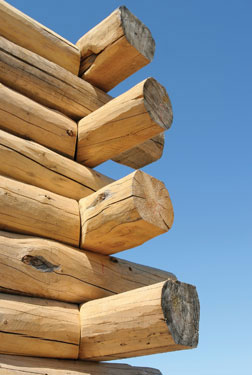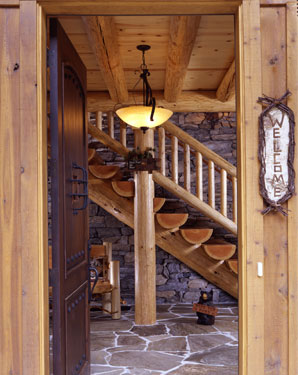 by Kimberly Blackford
by Kimberly Blackford

Photo Featuring Home by REAL LOG HOMES®, www.realloghomes.com, Photographer Roger Wade Studios
Sustainability and green home building have never been more popular than they have been in recent years. Builders and homeowners not only want a beautiful home, but something they deem environmentally conscious. They are looking for the perfect balance of beauty, style, efficiency and affordability. Sounds impossible, doesn’t it? Well, look no further because in many ways log homes are the “original green home.” How can a home style brought to life hundreds of years ago now be a green choice? Here are exactly the reasons why this beautiful and timeless style may be the perfect green home choice for you.
Log homes fit the latest housing trend perfectly as homeowners move towards greater environmental awareness by not robbing our environment of resources for our current wants and needs. When you decide to build a log home, you have taken the first step towards living green. If you compare constructing a log home with that of a conventional stick-built home, it takes less time, handling and processing to get to the end result. There is no waste when selecting trees because all parts of the tree are used. Log homes are naturally green because of the low processing costs and almost zero waste costs.
To start, wood is a natural, recyclable and renewable resource, so it can grow without using artificial energy. Although it must be harvested and somehow transported, the overall use of non-renewable energy is less than concrete or steel. Most of all, wood is a durable building material that can withstand the test of time for centuries. A log home can be deconstructed and its building materials recycled – but not before it has been around for 100 years or more! And since interior log walls are “surface as finish,” they do not require additional finishing that affects the air quality, so they maintain a better interior air quality within the home after it’s built. If you choose to finish the interior walls, then select low or no VOC stains, sealants or paints to maintain a green home environment.
According to the U.S. Department of Energy, solid wood homes, like log homes save 45% on heating and 24% on cooling over stick-built homes. They gain a lot of their energy efficiency from the sheer mass of their external walls. In real terms, a log home owner most likely would spend $150-$400 less per year on their heating and cooling utility bills while still maintaining comparable comfort levels to a conventionally built home in the same climate. Over the long-term, these savings can really add up!

There are also fewer materials used to construct this type of home since log homes rely on gravity rather than metal fasteners as the building settles. And, unlike conventionally built homes, a log home’s energy efficiency increases when it settles over time. Logs absorb heat energy during the day and radiate it at night. Also, remember homes with large expanses of glass and cathedral ceilings like many log home styles will consume less energy when oriented so that the glass areas face the south if you live in a colder climate, and position these large windows to the north if you live in a warmer climate. Why not get the sun’s warmth involved in saving you money too?
Another important benefit of log home building is the logs used for these homes are often delivered to construction sites within the area of harvest. This results in reduced transportation costs, and often the sawdust and small amount of wood remnants from these log facilities are available at no cost to people who use it for fuel, do-it-yourself projects and other woodcrafts in the local area. The sawdust from many of these mills is also provided free to local farmers. Often times, metal strapping and other materials are gathered and recycled. Many of these companies go the extra mile to make sure not only the finished product is a green home, but also how it came into fruition was handled just as responsibly in our world. Many log home producers are also involved in reforestation programs in which all parts of the tree are used and more trees are planted than cut. Green living in our world goes full-circle with each log home built.
Besides the log walls, there are also many other areas of the home that can be built using green materials further enhancing the energy efficiency of your log home. If you decide to build some dormers, for example, consider green insulation choices such as cellulose, mineral wool, soy foam or recycled cotton. When choosing cabinets, the EPA recommends those made from natural or sustainably harvested wood, certified locally grown woods, or salvaged cabinets that have been refurbished. The green options don’t stop there. The green choices for countertops in the kitchen and bath seem endless. Some of these choices include recycled metal or glass, natural stone or reclaimed woods. Flooring is another area where green options have really become more accessible with bamboo or reclaimed wood both being popular choices. After your efficient green home has been built, look for FSC-certified (Forest Stewardship Council) labels on furniture and other items you purchase to decorate your home.
Besides the fact that log homes are a beautiful part of America’s landscape, they are a crucial part of America’s long-term environmental plan. Log homeowners embrace the ideas of living a greener lifestyle. These individuals revere nature and consider their homes permanent dream homes that can last for generations. From the manufacturer, to the home builder to the homeowner, everyone is doing their part to make this a greener planet by building energy efficient homes like log homes.

Photo Featuring Home by
REAL LOG HOMES®, www.realloghomes.com,
Photographer James Ray Spahn
There are 9 key components to keep in mind that further enhance your green building and living experience whether you’ve built a log home or a conventionally built rustic home:
1) Build in a way that your home
doesn’t disturb the site.
2) Plan the home’s location around the sun.
3) Landscape using local plants to keep
from overwatering and fertilizing.
4) Choose non-toxic finishes and
no-VOC products.
5) Use Energy Star® Windows.
6) Rethink HVAC by considering radiant floor heating and geothermal heat pumps.
7) Use the sun’s warmth for better efficiency or install solar panels.
8) Install low consumption toilets and fixtures and also utilize a system that captures rainwater for
use around the home.
9) Buy Energy Star® appliances.
Here are some related articles:
Save this article to:
back to top